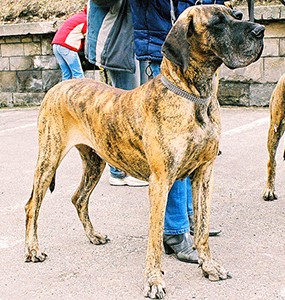Background
He’s the gentle giant of the dog world!
The Great Dane is huge, and that’s no accident. Most agree that his pedigree is a combination of English Mastiff and Irish Wolfhound, though we do know what the Great Dane is a very old breed. In fact, the Great Dane’s ancestors are visible on Egyptian ruins dating all the way back to 3,000 B.C. There’s some debate over whether his origin is Denmark or Germany, but we also know that the Great Dane was bred as a “Boarhound” – meant to hunt the intimidating European wild boar, the Great Dane is a combination of unmatched size and surprising speed.
His physical traits were part of the reason, for example, that English poet Alexander Pope famously kept a Great Dane for protection. Pope was small, sickly, and crippled, and he tended to make fun of a lot of his contemporaries, so he probably felt a lot safer when his towering dog, Bounce, followed him around when he left his writing desk.
In reality, though, the Great Dane is gentle and affectionate, making him one of the most popular breeds in the United States and beyond. 
Sizing Up
The Great Dane is one of the largest dog breeds in the world:
- Weight: 100-200 pounds
- Height: 28-32 inches (paw to shoulder)
- Coat: Short and smooth; light shedder
- Color: Fawn, brindle, black, blue, mantle
- Lifespan: 6-8 years
What are they like?
Seemingly aware of his great size, a properly socialized Great Dane can be very gentle and easygoing. The Great Dane can be protective when he needs to be, but the majority of the time he is affectionate and loves his people. He is also great around children, but it does take some training to be calm around kids. The Great Dane also gets along pretty well with other pets.
A true indoor dog, he just wants to be part of the family. Housetraining is easy, and he loves attention. The Great Dane is active, but not overly so, and a 15-30 minute walk each day is enough exercise.
The Great Dane is prone to some health problems that are important to know about:
- Bloat, which can lead to gastric dilatation volvulus, the number one cause of death in Great Danes
- Hip dysplasia
- Obesity
- Dilated Cardiomyopathy, or enlargement of the heart
- Wobbler's syndrome
Right for you?
As with any new pet, there are some considerations to make before you welcome big, happy-go-lucky Great Dane into your family:
- The Great Dane has to be trained and socialized from an early age. Without the proper training, he can be aggressive towards strange dogs, nervous around strange people, and a bull in a china closet as he barrels around the house.
- It might not seem like it, but the Great Dane is calm enough to be comfortable in an apartment or condo. It just takes some training to make sure he’s not knocking bookshelves over with his tail!
- Great Danes need A LOT of food. Think about the effect on your wallet – they can be very expensive to feed adequately.
- Because he’s so big, and because he susceptible to some health problems, the Great Dane’s life expectancy is quite a bit shorter than other breeds. If you’re interested in becoming the parent of a Great Dane, you need to know that you’ll lose him sooner than you’d like.
When trained well and exercised thoroughly, the Great Dane can be a great companion for the right person or family.
If you have any questions or concerns, you should always visit or call your veterinarian – they are your best resource to ensure the health and well-being of your pets.
